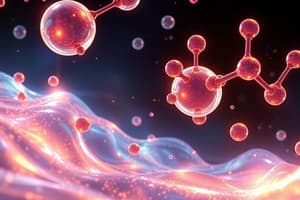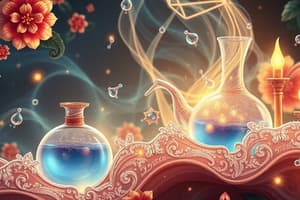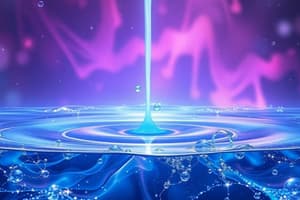Podcast
Questions and Answers
Which of the following liquids has a high viscosity?
Which of the following liquids has a high viscosity?
- Motor oil (correct)
- Water
- Gasoline
- Ethanol
The boiling point of water is 100 degrees Celsius under standard atmospheric pressure.
The boiling point of water is 100 degrees Celsius under standard atmospheric pressure.
True (A)
What does the molar heat of vaporization (ΔHvap) represent?
What does the molar heat of vaporization (ΔHvap) represent?
The amount of energy needed for 1 mole of a liquid to evaporate.
What relationship determines whether a substance is a solid, liquid, or gas according to the kinetic molecular theory?
What relationship determines whether a substance is a solid, liquid, or gas according to the kinetic molecular theory?
Water acts as both an acid and a base because it can donate and accept __________.
Water acts as both an acid and a base because it can donate and accept __________.
Intermolecular forces oppose kinetic energy in molecules.
Intermolecular forces oppose kinetic energy in molecules.
Match the following properties of water with their descriptions:
Match the following properties of water with their descriptions:
Define dipole-dipole interaction.
Define dipole-dipole interaction.
How does the strength of intermolecular forces relate to the viscosity of a liquid?
How does the strength of intermolecular forces relate to the viscosity of a liquid?
The formula for dipole moment is μ = Q × ______, where Q is the charge and r is the distance.
The formula for dipole moment is μ = Q × ______, where Q is the charge and r is the distance.
Match the types of intermolecular forces with their descriptions:
Match the types of intermolecular forces with their descriptions:
Water can only act as an acid.
Water can only act as an acid.
What is the primary element that water consists of?
What is the primary element that water consists of?
Which property of liquids is affected by intermolecular forces?
Which property of liquids is affected by intermolecular forces?
Crystalline solids have a regular arrangement of molecules, while amorphous solids do not.
Crystalline solids have a regular arrangement of molecules, while amorphous solids do not.
Explain how intermolecular forces affect vapor pressure.
Explain how intermolecular forces affect vapor pressure.
Which of the following describes dipole-induced dipole interactions?
Which of the following describes dipole-induced dipole interactions?
The London dispersion force is one of the strongest intermolecular forces.
The London dispersion force is one of the strongest intermolecular forces.
What is the primary cause of ion-dipole interactions?
What is the primary cause of ion-dipole interactions?
What characteristic do amorphous solids lack compared to crystalline solids?
What characteristic do amorphous solids lack compared to crystalline solids?
Amorphous solids have a sharp melting point.
Amorphous solids have a sharp melting point.
The property that allows a liquid to resist external force due to cohesive forces is called __________.
The property that allows a liquid to resist external force due to cohesive forces is called __________.
What happens to an amorphous solid when it is heated and then cooled slowly?
What happens to an amorphous solid when it is heated and then cooled slowly?
Which of the following statements about viscosity is true?
Which of the following statements about viscosity is true?
The process of converting a substance from solid to liquid is known as __________.
The process of converting a substance from solid to liquid is known as __________.
Cohesion refers to the attraction between molecules of different substances.
Cohesion refers to the attraction between molecules of different substances.
Match the following phase changes with their definitions:
Match the following phase changes with their definitions:
What intermolecular forces are present between H2O and CH3CH2OH?
What intermolecular forces are present between H2O and CH3CH2OH?
Which process refers to changing from a solid directly to a gas?
Which process refers to changing from a solid directly to a gas?
Deposition is the process of changing gas directly to a solid.
Deposition is the process of changing gas directly to a solid.
What is the freezing point of water?
What is the freezing point of water?
What is the complementary process to condensation?
What is the complementary process to condensation?
Ice sinks in water due to its higher density compared to liquid water.
Ice sinks in water due to its higher density compared to liquid water.
What type of solid is diamond classified as?
What type of solid is diamond classified as?
Water is described as the __________ solvent.
Water is described as the __________ solvent.
Match the following types of crystalline solids with their characteristics:
Match the following types of crystalline solids with their characteristics:
Which of the following statements about water's viscosity is true?
Which of the following statements about water's viscosity is true?
Molecular crystals are held together by ionic and covalent bonds.
Molecular crystals are held together by ionic and covalent bonds.
Name one example of a molecular crystal.
Name one example of a molecular crystal.
What is the term for the energy needed to vaporize 1 mole of liquid?
What is the term for the energy needed to vaporize 1 mole of liquid?
A supersaturated solution can hold more solute than a saturated solution at a given temperature.
A supersaturated solution can hold more solute than a saturated solution at a given temperature.
What is formed when a positive ion captures a free electron?
What is formed when a positive ion captures a free electron?
The phase diagram showcases the different states of substances under various __________ and __________ conditions.
The phase diagram showcases the different states of substances under various __________ and __________ conditions.
Match the following types of solutions with their definitions:
Match the following types of solutions with their definitions:
What property do supercritical fluids exhibit?
What property do supercritical fluids exhibit?
The triple point of water is the condition where solid, liquid, and gas coexist.
The triple point of water is the condition where solid, liquid, and gas coexist.
What does the term 'solubility' refer to?
What does the term 'solubility' refer to?
Flashcards
Kinetic Molecular Theory
Kinetic Molecular Theory
The kinetic molecular theory states that molecules are constantly in motion. The state of matter (solid, liquid, or gas) depends on the amount of motion these molecules exhibit.
Intermolecular Forces
Intermolecular Forces
Intermolecular forces (IMFs) are attractive forces between molecules. These forces oppose kinetic energy, keeping molecules close together.
Dipole Moment
Dipole Moment
A dipole moment (μ) measures the net polarity of a molecule. It is calculated by multiplying the magnitude of the charge (Q) at each end of the molecular dipole by the distance (r) between the charges.
Dipole-Dipole Interaction
Dipole-Dipole Interaction
Signup and view all the flashcards
Chemical Bond
Chemical Bond
Signup and view all the flashcards
Intermolecular Forces vs. Chemical Bonds
Intermolecular Forces vs. Chemical Bonds
Signup and view all the flashcards
Hydrogen Bonding
Hydrogen Bonding
Signup and view all the flashcards
London Dispersion Forces
London Dispersion Forces
Signup and view all the flashcards
Dipole-Induced Dipole Interaction
Dipole-Induced Dipole Interaction
Signup and view all the flashcards
Ion-Dipole Interaction
Ion-Dipole Interaction
Signup and view all the flashcards
Ion-Induced Dipole Interaction
Ion-Induced Dipole Interaction
Signup and view all the flashcards
Viscosity
Viscosity
Signup and view all the flashcards
Surface Tension
Surface Tension
Signup and view all the flashcards
Cohesion
Cohesion
Signup and view all the flashcards
Adhesion
Adhesion
Signup and view all the flashcards
Vapor Pressure
Vapor Pressure
Signup and view all the flashcards
Molar Heat of Vaporization (ΔHvap)
Molar Heat of Vaporization (ΔHvap)
Signup and view all the flashcards
Boiling Point
Boiling Point
Signup and view all the flashcards
Amphoteric
Amphoteric
Signup and view all the flashcards
Hydrolysis
Hydrolysis
Signup and view all the flashcards
Redox Reaction
Redox Reaction
Signup and view all the flashcards
Dielectric Constant
Dielectric Constant
Signup and view all the flashcards
Freezing Point of Water
Freezing Point of Water
Signup and view all the flashcards
Viscosity of Water
Viscosity of Water
Signup and view all the flashcards
Water as a Solvent
Water as a Solvent
Signup and view all the flashcards
Unit Cell
Unit Cell
Signup and view all the flashcards
Ionic Crystals
Ionic Crystals
Signup and view all the flashcards
Covalent Crystals
Covalent Crystals
Signup and view all the flashcards
Molecular Crystals
Molecular Crystals
Signup and view all the flashcards
Metallic Crystals
Metallic Crystals
Signup and view all the flashcards
Recombination
Recombination
Signup and view all the flashcards
Phase Diagram
Phase Diagram
Signup and view all the flashcards
Liquid-Vapor Equilibrium
Liquid-Vapor Equilibrium
Signup and view all the flashcards
Supercritical Fluid
Supercritical Fluid
Signup and view all the flashcards
Triple Point
Triple Point
Signup and view all the flashcards
Solute
Solute
Signup and view all the flashcards
Solubility
Solubility
Signup and view all the flashcards
Amorphous Solid
Amorphous Solid
Signup and view all the flashcards
Melting Point of Amorphous Solids
Melting Point of Amorphous Solids
Signup and view all the flashcards
Melting
Melting
Signup and view all the flashcards
Vaporization
Vaporization
Signup and view all the flashcards
Freezing
Freezing
Signup and view all the flashcards
Condensation
Condensation
Signup and view all the flashcards
Sublimation
Sublimation
Signup and view all the flashcards
Deposition
Deposition
Signup and view all the flashcards
Study Notes
General Chemistry 2 Topics
- The topics covered in General Chemistry 2 include the kinetic molecular theory of liquids and solids, intermolecular forces of attraction, properties of liquids, structure and properties of water, types and properties of solids, and phase changes.
- Learning targets for this lesson include using the kinetic molecular model to explain properties of liquids and solids, differentiating types of intermolecular forces, describing effects of intermolecular forces on liquid properties (like surface tension, viscosity etc.), explaining water's properties through its molecular structure, describing crystalline and amorphous solids, and describing phase changes and interpreting phase diagrams (water and carbon dioxide).
- The Kinetic Molecular Theory of Liquids and Solids states that molecules are in constant motion. The amount of motion determines if it is solid, liquid, or gas.
- Intermolecular forces hold molecules together and oppose kinetic energy. Stronger intermolecular forces mean molecules are closer together.
- Intermolecular forces affect properties of liquids such as surface tension, viscosity, vapor pressure, boiling point, and molar heat of vaporization. Stronger forces lead to higher values of these properties.
- Water has unique properties due to its molecular structure and intermolecular forces, including hydrogen bonding.
- Crystalline solids have a regular, well-defined arrangement of particles (atoms, ions, or molecules). Unit cells are repeating patterns.
- Covalent crystals are held together by strong covalent bonds, making them very hard and high-melting point solids. Examples include diamond.
Intermolecular Forces
- Intermolecular forces (IMFs) are attractive forces between molecules, not within them, and are weaker than bonds.
- Types of IMFs include dispersion forces, dipole-dipole forces, hydrogen bonding, ion-dipole forces, and ion-induced dipole forces.
- Dispersion forces are the weakest IMFs, resulting from temporary fluctuations in electron distribution.
- Dipole-dipole forces arise from attractions between polar molecules.
- Hydrogen bonding is a particularly strong dipole-dipole attraction involving hydrogen bonded to a highly electronegative atom (e.g., nitrogen, oxygen, fluorine).
- Ion-dipole forces occur when ions interact with polar molecules.
- Ion-induced dipole forces occur when an ion interacts with a non-polar molecule to induce a temporary dipole.
Properties of Liquids
- Surface tension is a liquid's resistance to an external force due to cohesive forces between molecules. High intermolecular forces lead to higher surface tension.
- Viscosity is a liquid's resistance to flow. High intermolecular forces lead to higher viscosity.
- Vapor pressure is the pressure exerted by a liquid's vapor above the liquid at equilibrium. Weaker forces mean a higher vapor pressure.
- Boiling point is the temperature at which a liquid's vapor pressure equals the external pressure. Higher boiling point equates to stronger forces.
- Molar heat of vaporization is the energy needed to vaporize one mole of a liquid at a constant temperature. Higher forces lead to a higher molar heat of vaporization.
Structure and Properties of Water
- Water has a unique structure due to hydrogen bonding, which leads to unusually high values for boiling point, melting point, and heat capacity.
- Water's unusual properties are important for many biological processes.
- Water is an amphoteric substance: it can act as an acid or a base.
- Water has a high dielectric constant this leads to its strong hydrating tendency.
- Water undergoes redox reactions and hydrolyzes.
Types and Properties of Solids
- Crystalline solids have a highly ordered arrangement of atoms, molecules, or ions (e.g., sodium chloride, diamond, sugar).
- Amorphous solids lack a long-range ordered structure, exhibiting a random arrangement of particles (e.g., glass, plastic).
Allotropes
- Allotropes are different molecular forms of the same element. Examples: Diamond, graphite, graphene, and nanotubes.
- Carbon, phosphorus, sulfur, and oxygen are examples of elements that exist as allotropes. Boron and antimony are also metalloids that have allotropes.
Phase Changes
- Phase changes are transitions between different states of matter (solid, liquid, gas, plasma).
- Phase changes include melting, freezing, vaporization, condensation, sublimation, deposition, ionization, and recombination.
- Phase diagrams show the conditions under which different phases exist and how the phases change as temperature or pressure changes. The triple point is where all three phases coexist. The critical point marks the limit of a liquid-gas phase change.
Solutions
- Solutions are homogeneous mixtures of two or more substances in which the solute is dissolved in the solvent.
- Types of solutions include saturated, unsaturated, and supersaturated solutions.
- Solubility is the maximum amount of solute that can dissolve in a given amount of solvent at a specific temperature and pressure. The principle "like dissolves like" applies.
Studying That Suits You
Use AI to generate personalized quizzes and flashcards to suit your learning preferences.




